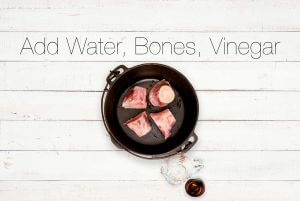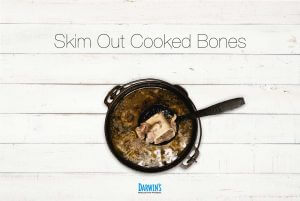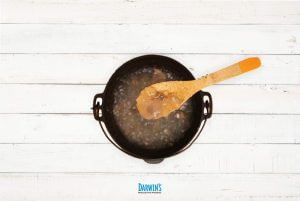Is Bone Broth Good for Dogs?
4/9/24

Bone Broth: A Comforting Superfood for Your Pets
With the changing seasons, serving warm comfort foods is the perfect way to add a touch of coziness to any time of year for pets and their people. For humans, there’s nothing quite like coming in from a bracing winter walk and snuggling up with a good book and a cup of tea. For dogs, a healthy bowl of warm, nourishing bone broth can have that same cozy, comforting effect.
For centuries, bone broth has been believed to have powerful healing properties. Most of us eat chicken soup when we’re sick. Hippocrates, the father of medicine, recommended bone broth as a digestive aid. Even our hunter-gatherer ancestors made bone broth as a way to use the parts of the animal that were too tough to eat otherwise. Today, we recognize that bone broth is not just a healthy addition to our diet, but also a fantastic addition to the diets of our pets.
But What is Bone Broth?
Bone broth is a clear liquid made by simmering bones, connective tissue, and sometimes meat, resulting in chicken broth or beef broth. It's also known as stock, and people use it for soups, sauces, or as a base for gravies. Some individuals even consume it on its own to obtain essential nutrients that support gut health, skin, muscles, joints, and the immune system.
Bone Broth is Great for Canine Joints
Quick biology refresher for those of us who haven’t sat in a classroom for some years: Tendons connect muscles to the bones, and ligaments connect bones to one another. Your pet needs both of these connective tissues to be strong and healthy to feel their best. The trouble is that these tissues break down over time, and we see our pets slow down. Healthy, easy-to-make bone broth can help provide the proteins needed for our pets to support and rebuild these tissues.
When you boil a bone, the marrow breaks down into gelatin. That gelatin contains collagen full of amino acids like proline and glycine, which are essential to canine joint health. Glycine, which is produced in limited amounts by the liver, is also a key factor in your pet’s detoxification process. Limited glycine means a limited ability to detoxify. Bolstering the amount of glycine in your pet’s diet can help support the liver.
Bone Broth Helps Ease Arthritis in Senior Pets
Pets are living longer than ever, but arthritis concerns parents with senior pets. As our pets age, the protective layer of cartilage between their bones can thin. This thinning leads to increased wear and tear on the joint, which causes inflammation, fluid buildup, and, worst of all, pain. Bone broth is a natural source of the glucosamine-chondroitin one-two punch that is proven to help keep cartilage healthy and joint pain at bay.
Bone Broth is a Fantastic Nutritional Support for Sick Pups
From time to time, every pet gets sick. No one likes to see their pet suffering from vomiting or diarrhea. Offering bone broth will not only increase fluid consumption but also offers much-needed nutrients at a time when your pet most needs a boost.
Bone Broth is Easy and Inexpensive to Make at Home
It’s the ultimate lazy way to spoil your pet because all it takes is a bit of chopping and some patience. Anyone can make bone broth. It doesn’t require any special skills or tools. You can do it in a slow cooker (my favorite), on the stove, or in a pressure cooker. If you can boil water, you can make healthy, nourishing bone broth for pets.
Bone Broth Recipe for Pets
Ingredients
- Raw Apple Cider Vinegar
- Raw Marrow Bones (Darwin’s sells the perfect bones for this, and you can even let your pet have a bit of a chew on them before you use them in your broth.)
Optional Add-Ins to Boost Nutrition and Flavor:
- Carrots, spinach, celery, or other dog-friendly vegetables
- Parsley, dandelion, turmeric, oregano, or other dog-friendly herbs
- Kelp
- Liver, diced into small pieces (great for boosting flavor and enticing picky pets to drink)
How to Make Bone Broth for Pets

1. Layer bones on the bottom of your crock or stock pot. Fill a pot with water so bones are completely covered, plus 2 to 3 inches. Add liver pieces for flavor, if desired. Add a generous splash (approximately 3 to 4 tablespoons) of raw apple cider vinegar to the pot. The acidity of the vinegar is the magic ingredient that will help unlock all those good things in the bones and infuse the broth with them.

2. Cook over medium-high heat for one hour, then turn down to low and simmer for 24 to 36 hours. (If you are cooking on the stovetop, you can place it in the fridge overnight and return it to the heat in the morning.) During the last 30 minutes, add any additional vegetables if desired. This will cook the veggies just enough to release their nutritional value without turning them to mush. During the last 10 minutes, add any herbs or supplements, such as parsley, dandelion, or turmeric.

3. Remove from heat, and skim any foam off the top. Strain any bones that have not broken down.

4. Place broth in the fridge to chill completely. A hard crust of fat will develop on the top. Chip this off and discard it in your compost bin or trash can.

5. Your pot should be filled with a thick, jelly-like substance packed with great nutrition for your dogs.

To store it, ladle it into jars, seal them, and place them in the fridge or freezer. Like all fresh foods, the bone broth will keep in the fridge for several days or the freezer for several months. It’s really handy to make a big batch and freeze it. You can even freeze it in ice cube trays and defrost small servings as needed.
To serve bone broth, spoon cold broth over your pet’s regular meals or heat gently for a warm, nourishing treat.
Other Health Benefits of Dog Bone Broth
- Hydration: If your dog is experiencing dehydration or diarrhea, giving them some beef bone broth can help rehydrate and nourish them. When whole dog food isn't appealing to a senior dog or when you have a sick dog, nourishing them with broth can provide the essential nutrients they need, including hydration.
- Liver Support : There's no doubt that your furry friend enjoys eating unexpected things when you least expect it, and maintaining their healthy liver, which is excellent at filtering and detoxifying everyday and unexpected foods, is crucial. Adding bone broth to a dog’s diet supports liver health with essential amino acids that help remove toxins.
- Healthy Skin and Coat: Collagen, an essential nutrient for maintaining your pets' healthy skin and coat, is naturally present in bone broth as it dissolves from the bones during cooking. As dogs age, they begin to lose this protein, making collagen important for maintaining a beautiful coat, healthy skin, and even strong ligaments, tendons, and bones.
- Gut Health: Collagen can be broken down into amino acids, which are important important in food digestion. Gelatin is also found in bone broth, which can help soothe leaky gut syndrome. This syndrome damages the intestinal wall, causing undigested food, toxins, and bacteria to leak through the intestinal wall and into the bloodstream. So, whether you make homemade bone broth or buy beef or chicken bone broth, it can soothe leaky gut syndrome and digestive discomfort in a dog's body.
SOURCES:
[1] https://www.webmd.com/diet/health-benefits-bone-broth



